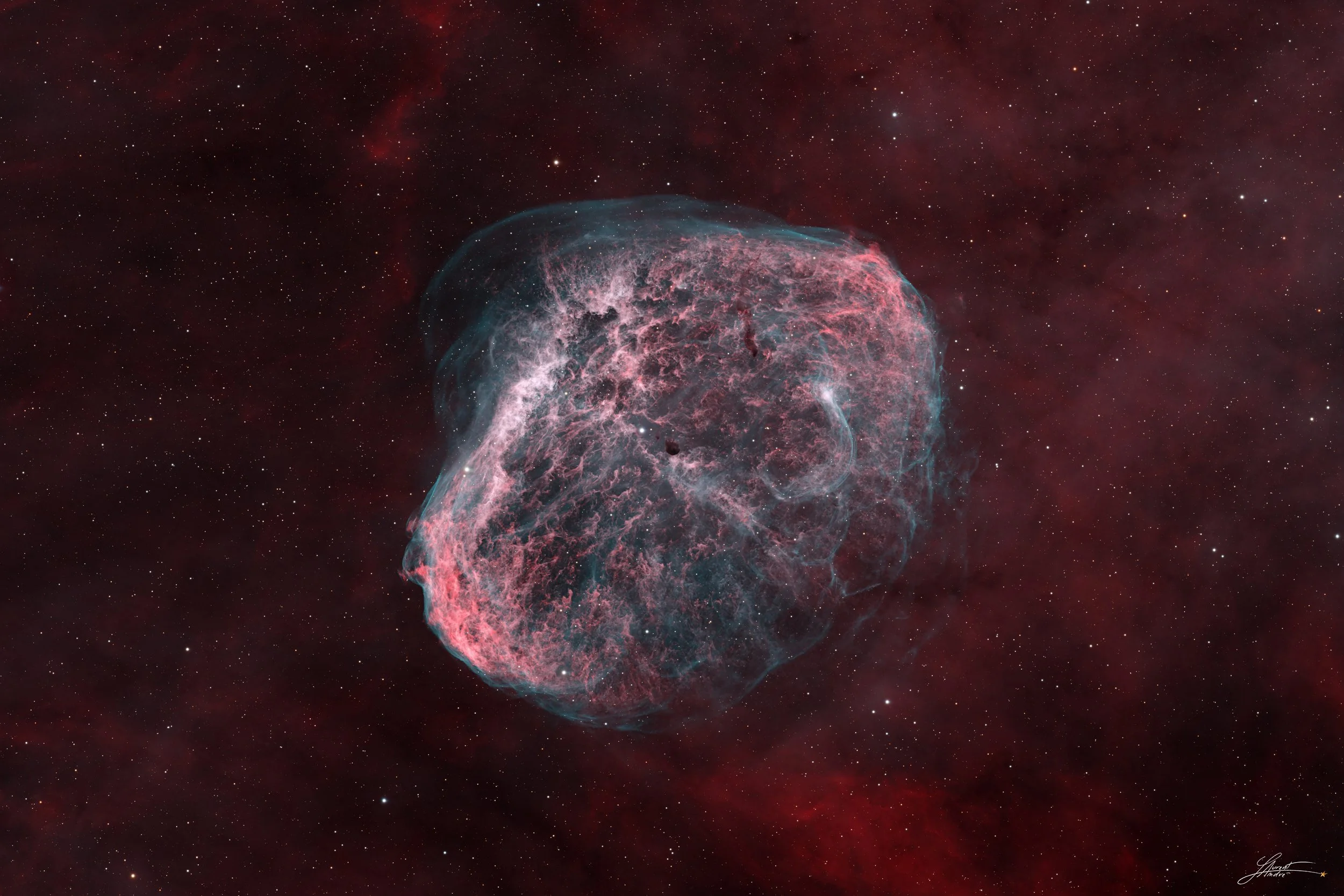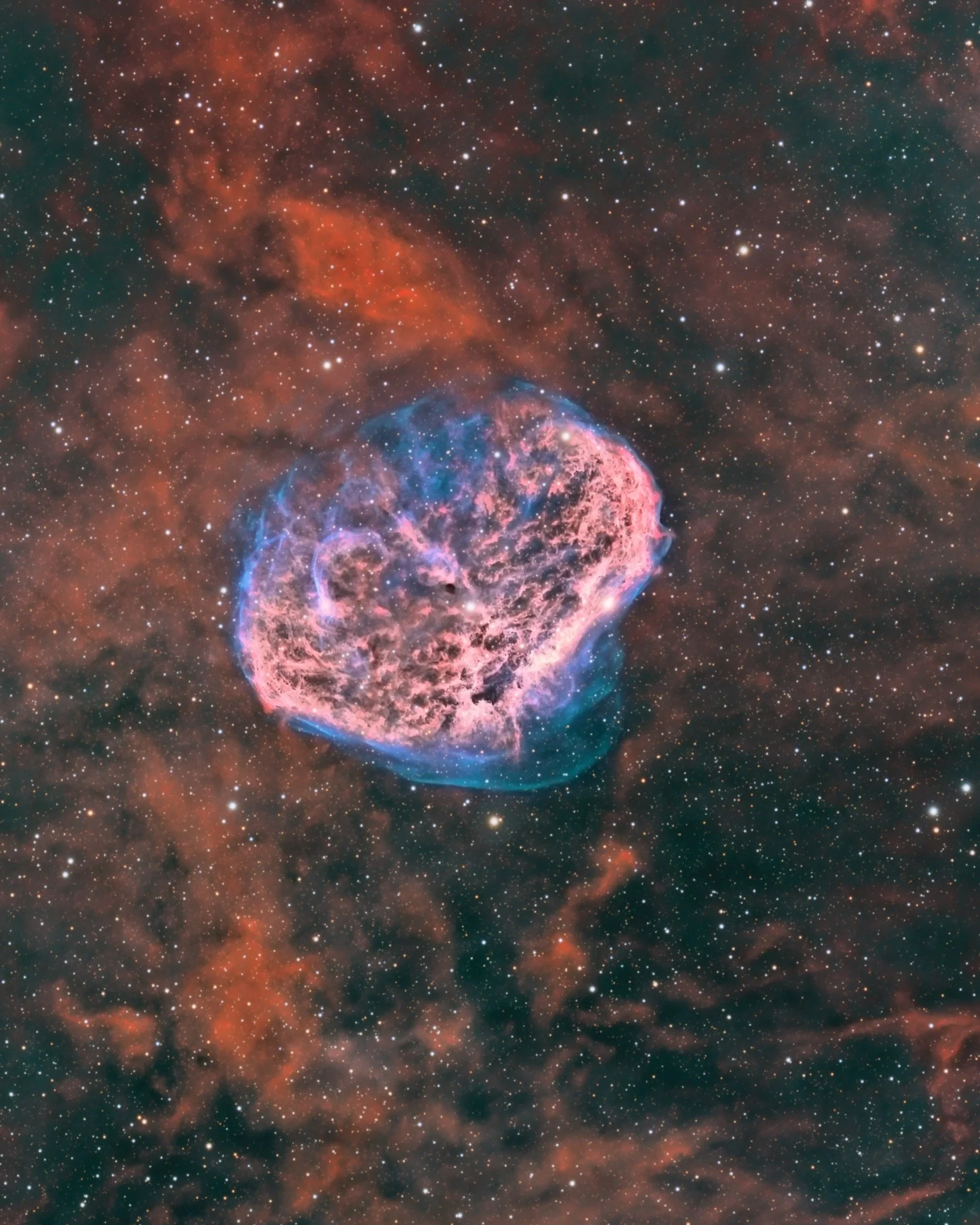
AAPOD2 Image Archives
The Crescent and Soap Bubble Nebulae; Two Paths of Stellar Death
This narrowband portrait captures the Crescent Nebula and the elusive Soap Bubble Nebula suspended in the rich emission fields of Cygnus. The Crescent forms where a fast stellar wind from its Wolf Rayet star collides with slower material ejected in an earlier phase, sculpting a glowing shell of ionized hydrogen and oxygen. Nearby, the faint Soap Bubble reveals a nearly perfect sphere, a rare planetary nebula whose razor thin shell becomes visible only under deep integration.
Captured with the remote dual FF130 setup at Pixelskies in Southern Spain, this dataset blends contributions from both telescopes to resolve the intricate shock fronts and delicate filaments. The combination of careful acquisition by Jamie and Phil, meticulous pre-processing by Phil, and refined post-processing by Jamie brings forward subtle structures that are often hidden, including the Soap Bubble’s extremely low surface brightness envelope floating within the surrounding HII region.
NGC6888 -The Crescent Nebula
Lighting up the constellation Cygnus, the Crescent Nebula (NGC 6888) shines like cosmic fireworks, a fitting farewell to the year that was. This glowing arc of gas and dust is the product of a massive Wolf-Rayet star nearing the end of its life. Intense stellar winds collide with material shed from the star’s earlier phases, sculpting this vibrant and dynamic structure.
Its fiery hues and intricate filaments mirror the brilliance of a midnight celebration, where endings and beginnings collide in a dazzling display. Spanning about 25 light-years, the Crescent Nebula serves as a reminder that even as one chapter closes, the universe is always creating something new and beautiful.
From all of us at AAPOD2, Happy New Year to our amazing members! May the year ahead be filled with clear skies, stunning captures, and endless wonder. 🌌✨
The Golden Crescent and the Soap Bubble.
This image was acquired from my backyard in Victoria Texas. Featuring the famous Crescent Nebula, the well known target in Cygnus, but processed in Dynamic Narrowband Combination, to bring out the intricate Ha filaments in this shiny golden color. There are many other stories in this field of view, as the Soap Bubble makes an appearance at the top of the frame. To the far left of the frame, Abell 69 makes an appearance at an apparent size of only 22".
The Crescent nebula and its central star WR136
Wolf-Rayet stars are evolved, massive stars that have shed their outer layers, revealing a hot and dense core. WR 136 is no exception, displaying strong stellar winds that propel material into space. These winds create a nebula around the star, contributing to the surrounding interstellar environment.
The binary nature of WR 136 adds another layer of interest. The companion star, which is not a Wolf-Rayet star, orbits the primary star, influencing its evolution and contributing to the dynamics of the system.
NGC 6888 Crescent
NGC 6888, known as the "Crescent Nebula," is an emission nebula located in the constellation Cygnus. It's formed by the powerful stellar wind from a Wolf-Rayet star colliding with the surrounding interstellar material, creating its distinctive crescent shape. A fascinating aspect of this nebula is the presence of intricate, filamentary structures illuminated by the energetic radiation emitted by the central star, resulting in a captivating interplay of light and gas.
From North America to Crescent (Mosaic)
Image Description and Details : Three panel mosaic of the central region of Cygnus constellation. From left to right, in order of appareance, the North America Nebula (NGC 7000), the Pelican Nebula (IC 5070), the Butterfly Nebula (IC 1318), the Crescent Nebula. At the bottom right, some molecular clods and dark nebulae.
Framing was planned with the software NINA, the single subs stacked with DeepSkyStacker, and the panels merged with Astropixelprocessor. Processing with Pixinsight and Photoshop.
Gear and technical data:
Samyang 135 @ f/4
QHY183C
Optolong L-enhance filter
30 subs x 3 panels x 180s
Copyright: Antonio Grizzuti
THE CRESCENT
34hr 31min total exposure time
96x300” Ha
119x300” Oiii
150x60” R
66x60” G
74x60” B
40x Darks360 Flats/Dark Flats06/13-15,06/17-18, 06/21-22, 07/22, 08/03, 08/13/2021Bortle 6/7Calgary, ABSetup#1 - HHOHO 711mm Focal Lengthwilliam optics GT102william optics Flat68iiiantlia filters HO 3nm, 2”antlia filters RGB, 2”sky watcher usa EQ6-R Prozwo asi ASI2600MM-Pro, unity, -10Czwo asi EAFzwo asi EFW 7x2, 2”zwo asi OAG68Mzwo asi ASI290MM-minizwoasi ASIAir Pro
APP, PI, PS, MLR
Copyright: Andrew Lesser
Crescent and Tulip Nebulae Wide field
Image Description and Details : Widefield image of a nebula-dense region in the constellation Cygnus. The image contains the crescent nebula in the top right and the tulip nebula in the lower left.
OIII: 120x300" (10h) bin 1x1
Hɑ: 135x300" (11h 15') bin 1x1
SII: 106x300" (8h 50') bin 1x1
Gain: 111.00; -15C
Total Integration: 30h
Camera: ZWO 183MM Pro
Lens: Rokinon 135 f/2
Mount: Sky-Watcher EQ6R Pro
Copyright: Frank Turina
cygnus mosaic
I have started this imaging project back at 2010. My aim was to make a high resolution mosaic covering the constellation Cygnus. Work like that takes time and patience, especially since I have worked so, that many of the individual sub mosaics or frames have been published as an individual artworks. Here is a poster format presentation about all of longer focal length images used for this mosaic beside wide field panels.
As a result I have now a huge 37 panel (And 58 long focal length sub-panel) mosaic panorama covering 28 x 18 degrees of sky. I have collected photons way over 600 hours during past ten years for this photo. The full size mosaic image has a size of about 25.000 x 15.000 pixels.
In the orientation image above, there are three large supernova remnants visible, first the Cygnus Shell W63 , bluish ring at upper left quarter, secondly the large SNR G65.3+5.7 at utmost right and finally the third is a brighter SNR, the Veil nebula just outside of field of view at bottom center. (Image is partly overlapping with large mosaic but I didn't want to include it yet due to artistic composition.)Beside three supernova remnants there are two Wolf Rayet stars with outer shell formations. NGC 6888, the Crescent Nebula at center of the image and the WR 134, it can be seen as a blue arch just right from the Crescent Nebula, near the Tulip nebula.Next to the Tulip Nebula lays a Black hole Cygnus X-1, it's marked in small closeup image of the Tulip Neula at center right in orientation image above.
There are 37 base panels with shorter focal length tools (300mm f2.8 Tokina and 200mm f1.8 Canon) There is also 59 sub-panels used, they are shot with my old 12" Meade and 11" Celestron Edge scopes.
Copyright: J-p Metsavainio









